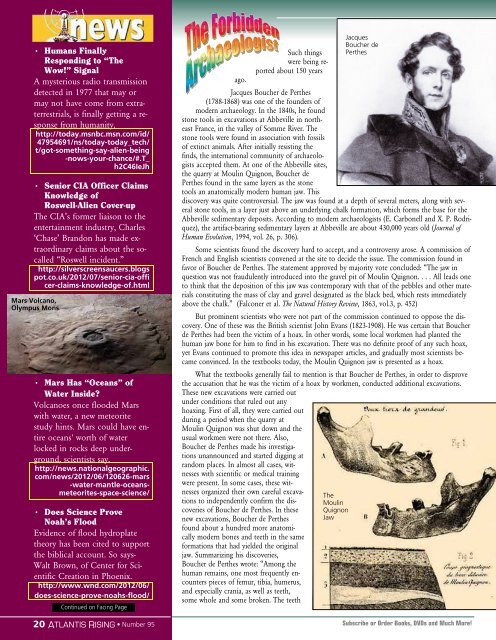Do We Know What We Think We Know About ... - TheUFOStore.com
Do We Know What We Think We Know About ... - TheUFOStore.com
Do We Know What We Think We Know About ... - TheUFOStore.com
Create successful ePaper yourself
Turn your PDF publications into a flip-book with our unique Google optimized e-Paper software.
• Humans Finally<br />
Responding to “The<br />
Wow!” Signal<br />
A mysterious radio transmission<br />
detected in 1977 that may or<br />
may not have <strong>com</strong>e from extraterrestrials,<br />
is finally getting a response<br />
from humanity.<br />
http://today.msnbc.msn.<strong>com</strong>/id/<br />
47954691/ns/today-today_tech/<br />
t/got-something-say-alien-being<br />
-nows-your-chance/#.T_<br />
h2C46IeJh<br />
• Senior CIA Officer Claims<br />
<strong>Know</strong>ledge of<br />
Roswell-Alien Cover-up<br />
The CIA’s former liaison to the<br />
entertainment industry, Charles<br />
‘Chase’ Brandon has made extraordinary<br />
claims about the socalled<br />
“Roswell incident.”<br />
http://silverscreensaucers.blogs<br />
pot.co.uk/2012/07/senior-cia-offi<br />
cer-claims-knowledge-of.html<br />
Mars Volcano,<br />
Olympus Mons<br />
• Mars Has “Oceans” of<br />
Water Inside?<br />
Volcanoes once flooded Mars<br />
with water, a new meteorite<br />
study hints. Mars could have entire<br />
oceans' worth of water<br />
locked in rocks deep underground,<br />
scientists say.<br />
http://news.nationalgeographic.<br />
<strong>com</strong>/news/2012/06/120626-mars<br />
-water-mantle-oceansmeteorites-space-science/<br />
• <strong>Do</strong>es Science Prove<br />
Noah’s Flood<br />
Evidence of flood hydroplate<br />
theory has been cited to support<br />
the biblical account. So says-<br />
Walt Brown, of Center for Scientific<br />
Creation in Phoenix.<br />
http://www.wnd.<strong>com</strong>/2012/06/<br />
does-science-prove-noahs-flood/<br />
Continued on Facing Page<br />
20 ATLANTIS ATLANTIS RISING RISING • Number 95<br />
ago.<br />
Such things<br />
were being reported<br />
about 150 years<br />
Jacques Boucher de Perthes<br />
(1788-1868) was one of the founders of<br />
modern archaeology. In the 1840s, he found<br />
stone tools in excavations at Abbeville in northeast<br />
France, in the valley of Somme River. The<br />
stone tools were found in association with fossils<br />
of extinct animals. After initially resisting the<br />
finds, the international <strong>com</strong>munity of archaeologists<br />
accepted them. At one of the Abbeville sites,<br />
the quarry at Moulin Quignon, Boucher de<br />
Perthes found in the same layers as the stone<br />
tools an anatomically modern human jaw. This<br />
discovery was quite controversial. The jaw was found at a depth of several meters, along with several<br />
stone tools, in a layer just above an underlying chalk formation, which forms the base for the<br />
Abbeville sedimentary deposits. According to modern archaeologists (E. Carbonell and X. P. Rodriquez),<br />
the artifact-bearing sedimentary layers at Abbeville are about 430,000 years old (Journal of<br />
Human Evolution, 1994, vol. 26, p. 306).<br />
Some scientists found the discovery hard to accept, and a controversy arose. A <strong>com</strong>mission of<br />
French and English scientists convened at the site to decide the issue. The <strong>com</strong>mission found in<br />
favor of Boucher de Perthes. The statement approved by majority vote concluded: “The jaw in<br />
question was not fraudulently introduced into the gravel pit of Moulin Quignon. . . . All leads one<br />
to think that the deposition of this jaw was contemporary with that of the pebbles and other materials<br />
constituting the mass of clay and gravel designated as the black bed, which rests immediately<br />
above the chalk.” (Falconer et al. The Natural History Review, 1863, vol.3, p. 452)<br />
But prominent scientists who were not part of the <strong>com</strong>mission continued to oppose the discovery.<br />
One of these was the British scientist John Evans (1823-1908). He was certain that Boucher<br />
de Perthes had been the victim of a hoax. In other words, some local workmen had planted the<br />
human jaw bone for him to find in his excavation. There was no definite proof of any such hoax,<br />
yet Evans continued to promote this idea in newspaper articles, and gradually most scientists became<br />
convinced. In the textbooks today, the Moulin Quignon jaw is presented as a hoax.<br />
<strong>What</strong> the textbooks generally fail to mention is that Boucher de Perthes, in order to disprove<br />
the accusation that he was the victim of a hoax by workmen, conducted additional excavations.<br />
These new excavations were carried out<br />
under conditions that ruled out any<br />
hoaxing. First of all, they were carried out<br />
during a period when the quarry at<br />
Moulin Quignon was shut down and the<br />
usual workmen were not there. Also,<br />
Boucher de Perthes made his investigations<br />
unannounced and started digging at<br />
random places. In almost all cases, witnesses<br />
with scientific or medical training<br />
were present. In some cases, these wit-<br />
nesses organized their own careful excavations<br />
to independently confirm the discoveries<br />
of Boucher de Perthes. In these<br />
new excavations, Boucher de Perthes<br />
found about a hundred more anatomically<br />
modern bones and teeth in the same<br />
formations that had yielded the original<br />
jaw. Summarizing his discoveries,<br />
Boucher de Perthes wrote: “Among the<br />
human remains, one most frequently encounters<br />
pieces of femur, tibia, humerus,<br />
and especially crania, as well as teeth,<br />
some whole and some broken. The teeth<br />
The<br />
Moulin<br />
Quignon<br />
Jaw<br />
Jacques<br />
Boucher de<br />
Perthes<br />
Subscribe or Order Books, DVDs and Much More!


